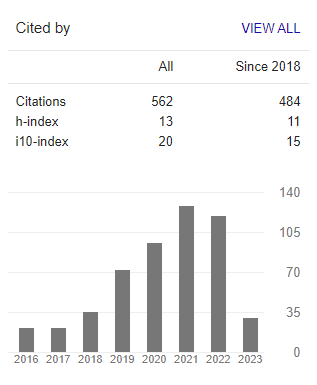THE NEW ETHIOPIAN HATE SPEECH AND DISINFORMATION PREVENTION PROCLAMATION: A Sign for Fracture of the Promises of the Reform?
Abstract
This article studies the new Hate Speech and Disinformation prevention and suppression proclamation No. 1185/2020 that the government of Ethiopia endorsed recently. Contrary to the promises of Reform by Prime Minister Abiy Ahmed in 2018, the Law that has been ratified in 2020. The study employed the method of 'Qualitative Case study' with 'Evidence of Effect' and Realist approaches to the systematic review of literature on Ethiopian Reform and the procedures followed to ratify the draft Bill. It analyzed the draft bill document as a case study reflecting the current state of media freedom in Ethiopia. Supported by some key informant interviews, related literature on media pluralism, press freedom, news reports, and International Organizations such as Human Rights Watch and UNESCO on Hate Speech and Disinformation Proclamation are examined. The result shows that PM Abiy Ahmed has been very ambitious in early actions and decisions in the reform process. However, the internal political crises created polarization in the contents of various media and compelled the draft Law's ratification. The Document of the Proclamation Lacked Clarity in the definition of terms. As a result, it created misunderstandings in the implementation and justifications of the ratified proclamation, as disinformation is only one element of different types of misinformation. It is also unclear why the proclamation repealed the article it assumed to repeal in the Criminal Code of the Federal Democratic Republic of Ethiopia, while there are other related articles. Furthermore, the Law will suppress press freedom and media pluralism which are potential democratic ideals as the country is heading for a democratic political transition. Therefore, to minimize government indiscretion, policymakers must reexamine the substance and drafting of the Law to close the gaps.
To cite this article (7th APA style):
Eranfeno, G. N. (2022). The new Ethiopian hate speech and disinformation prevention proclamation: A sign for fracture of the promises of the reform? Journal Communication Spectrum: Capturing New Perspectives in Communication 12(2), 112-123. https://doi.org/10.36782/jcs.v12i2.2186Keywords
References
Alemu, G. (2020, January 24). Narrow hate speech law will not broaden minds. Ethiopia Insight. https://www.ethiopia-insight.com/2020/01/24/narrow-hate-speech-law-will-not-broaden-minds/
BBC News. (2021, June 8). Ethiopia profile - Media. https://www.bbc.com/news/world-africa-13349401
Brown, A. (2017). What is hate speech? Part 2: Family resemblances. Law and Philosophy, 36(5), 561-613. https://doi.org/10.1007/s10982-017-9300-x
Chekol, M. A. (2019). A shift of political discourse: Critical discourse analysis of ethiopian prime minister Dr. Abiy Ahmed’s inaugural speech. Advances in Sciences and Humanities, 5(5), 128-137. https://doi.org/10.11648/j.ash.20190505.13
Chekol, M. A., Moges, M. A., & Nigatu, B. A. (2021). Social media hate speech in the walk of Ethiopian political reform: Analysis of hate speech prevalence, severity, and natures. Information, Communication & Society, 1-20. https://doi.org/10.1080/1369118x.2021.1942955
Creswell, J. W. (2014). Research design: Qualitative, quantitative, and mixed methods approaches (4th ed.). SAGE Publications.
De Mauro, A., Greco, M., & Grimaldi, M. (2019). Understanding big data through a systematic literature review: The ITMI model. International Journal of Information Technology & Decision Making, 18(04), 1433-1461. https://doi.org/10.1142/s0219622019300040
Endaylalu, G. A. (2022). The grand missed opportunities for change in the modern ethiopian political history: Lesson to be learnt for contemporary democratic transition. International Relations and Diplomacy, 10(1), 33-49. https://doi.org/10.17265/2328-2134/2022.01.003
Fallis, D. (2011). Floridi on disinformation. Etica & Politica / Ethics & Politics, 13(2), 201-214. http://hdl.handle.net/10077/5802
Federal Democratic Republic of Ethiopia (2020). Hate Speech and Disinformation Prevention and Suppression Proclamation (No.1185/2020). https://www.lawethiopia.com/index.php/volume-3/6504-hate-speech-and-disinformation-prevention-and-suppression-proclamation
Fish, S. (1997). Boutique multiculturalism, or why liberals are incapable of thinking about hate speech. Critical Inquiry, 23(2), 378-395. https://doi.org/10.1086/448833
Harrison, H. C., Birks, M., Franklin, R., & Mills, J. E. (2017). Case study research: Foundations and methodological orientations. Forum Qualitative Sozialforschung / Forum: Qualitative Social Research, 18(1). https://doi.org/10.17169/fqs-18.1.2655
Human Rights Watch. (2019, December 19). Ethiopia: Bill threatens free expression. https://www.hrw.org/news/2019/12/19/ethiopia-bill-threatens-free-expression
Jakubowicz, K. (2015). Trends in media pluralism. In World trends in freedom of expression and media development (3rd ed., pp. 66-100). UNESCO Publishing. https://unesdoc.unesco.org/ark:/48223/pf0000261065
Jima, A. O. (2021). Vicious circle of Ethiopian politics: Prospects and challenges of current political reform. Cogent Social Sciences, 7(1), 1893908. https://doi.org/10.1080/23311886.2021.1893908
Lie, J. H. S., & Mesfin, B. (2018). Ethiopia: A political economy analysis (NUPI 2018-04 [1582164]). Norwegian Institute of International Affairs. http://hdl.handle.net/11250/2496505
Pilling, D. & Barber, L. (2019, February 21). Ethiopia’s Abiy Ahmed: Africa’s new talisman. Financial Times. https://www.ft.com/content/abe678b6-346f-11e9-bb0c-42459962a812
Ramdhani, A., Ramdhani, M. A., & Amin, A. S. (2014). Writing a literature review research paper: A step-by-step approach. International Journal of Basic and Applied Science, 3(1), 47-56. http://digilib.uinsgd.ac.id/5129/
Santuraki, S. U. (2019). Trends in the regulation of hate speech and fake news: A threat to free speech? Hasanuddin Law Review, 5(2), 140. https://doi.org/10.20956/halrev.v5i2.1625
Snyder, H. (2019). Literature review as a research methodology: An overview and guidelines. Journal of Business Research, 104, 333-339. https://doi.org/10.1016/j.jbusres.2019.07.039
Solomon, S. (2019, December 20). Rights group calls new law in Ethiopia a threat to freedom of expression. VOA. https://www.voanews.com/a/press-freedom_rights-group-calls-new-law-ethiopia-threat-freedom-expression/6181387.html
UNESCO. (2019). World Press Freedom Day 2019: Final report (CI-2019/WPFD/1). UNESCO Publishing. https://unesdoc.unesco.org/ark:/48223/pf0000368964
Valcke, P., Sükösd, M., & Picard, R. E. (Eds.). (2015). Media pluralism and diversity: Concepts, risks and global trends. Palgrave Macmillan. https://doi.org/10.1057/9781137304308
Warner, W., & Hirschberg, J. (2012). Detecting hate speech on the World Wide Web. In Proceedings of the Second Workshop on Language in Social Media (p. 19–26). Association for Computational Linguistics. https://aclanthology.org/W12-2103
Wijaya, B. S. (2022). On the corruption of communication: A theory of deception. Studies in Media and Communication, 10(2), 129-144. https://doi.org/10.11114/smc.v10i2.5500
Wood, L., Sebar, B., & Vecchio, N. (2020). Application of rigour and credibility in qualitative document analysis: Lessons learnt from a case study. The Qualitative Report, 25(2), 456-470. https://doi.org/10.46743/2160-3715/2020.4240
Workneh, T. W. (2020). Social media, protest, & outrage communication in Ethiopia: Toward fractured publics or pluralistic polity? Information, Communication & Society, 24(3), 309-328. https://doi.org/10.1080/1369118x.2020.1811367
Xiao, Y., & Watson, M. (2017). Guidance on conducting a systematic literature review. Journal of Planning Education and Research, 39(1), 93-112. https://doi.org/10.1177/0739456x17723971
Refbacks
- There are currently no refbacks.

This work is licensed under a Creative Commons Attribution 3.0 License.
Indexed by:
Archived in:
Listed in:
INTERNATIONAL ASSOCIATION FOR MEDIA AND COMMUNICATION RESEARCH

















